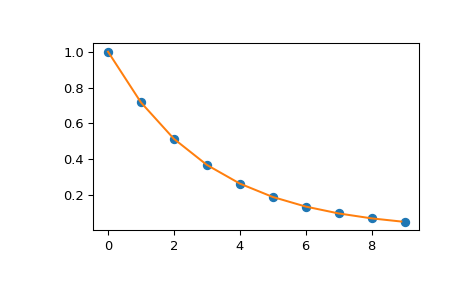interp1d#
- class scipy.interpolate.interp1d(x, y, kind='linear', axis=-1, copy=True, bounds_error=None, fill_value=nan, assume_sorted=False)[source]#
Interpolate a 1-D function (legacy).
Legacy
This class is considered legacy and will no longer receive updates. While we currently have no plans to remove it, we recommend that new code uses more modern alternatives instead. For a guide to the intended replacements for
interp1dsee 1-D interpolation.x and y are arrays of values used to approximate some function f:
y = f(x). This class returns a function whose call method uses interpolation to find the value of new points.- Parameters:
- x(npoints, ) array_like
A 1-D array of real values.
- y(…, npoints, …) array_like
An N-D array of real values. The length of y along the interpolation axis must be equal to the length of x. Use the
axisparameter to select correct axis. Unlike other interpolators, the default interpolation axis is the last axis of y.- kindstr or int, optional
Specifies the kind of interpolation as a string or as an integer specifying the order of the spline interpolator to use. The string has to be one of ‘linear’, ‘nearest’, ‘nearest-up’, ‘zero’, ‘slinear’, ‘quadratic’, ‘cubic’, ‘previous’, or ‘next’. ‘zero’, ‘slinear’, ‘quadratic’ and ‘cubic’ refer to a spline interpolation of zeroth, first, second or third order; ‘previous’ and ‘next’ simply return the previous or next value of the point; ‘nearest-up’ and ‘nearest’ differ when interpolating half-integers (e.g. 0.5, 1.5) in that ‘nearest-up’ rounds up and ‘nearest’ rounds down. Default is ‘linear’.
- axisint, optional
Axis in the
yarray corresponding to the x-coordinate values. Unlike other interpolators, defaults toaxis=-1.- copybool, optional
If
True, the class makes internal copies of x and y. IfFalse, references toxandyare used if possible. The default is to copy.- bounds_errorbool, optional
If True, a ValueError is raised any time interpolation is attempted on a value outside of the range of x (where extrapolation is necessary). If False, out of bounds values are assigned
fill_value. By default, an error is raised unlessfill_value="extrapolate".- fill_valuearray-like or (array-like, array_like) or “extrapolate”, optional
if a ndarray (or float), this value will be used to fill in for requested points outside of the data range. If not provided, then the default is NaN. The array-like must broadcast properly to the dimensions of the non-interpolation axes.
If a two-element tuple, then the first element is used as a fill value for
x_new < x[0]and the second element is used forx_new > x[-1]. Anything that is not a 2-element tuple (e.g., list or ndarray, regardless of shape) is taken to be a single array-like argument meant to be used for both bounds asbelow, above = fill_value, fill_value. Using a two-element tuple or ndarray requiresbounds_error=False.Added in version 0.17.0.
If “extrapolate”, then points outside the data range will be extrapolated.
Added in version 0.17.0.
- assume_sortedbool, optional
If False, values of x can be in any order and they are sorted first. If True, x has to be an array of monotonically increasing values.
- Attributes:
fill_valueThe fill value.
Methods
__call__(x)Evaluate the interpolant
See also
splrep,splevSpline interpolation/smoothing based on FITPACK.
UnivariateSplineAn object-oriented wrapper of the FITPACK routines.
interp2d2-D interpolation
Notes
Calling
interp1dwith NaNs present in input values results in undefined behaviour.Input values x and y must be convertible to float values like int or float.
If the values in x are not unique, the resulting behavior is undefined and specific to the choice of kind, i.e., changing kind will change the behavior for duplicates.
Array API Standard Support
interp1dis not in-scope for support of Python Array API Standard compatible backends other than NumPy.See Support for the array API standard for more information.
Examples
>>> import numpy as np >>> import matplotlib.pyplot as plt >>> from scipy import interpolate >>> x = np.arange(0, 10) >>> y = np.exp(-x/3.0) >>> f = interpolate.interp1d(x, y)
>>> xnew = np.arange(0, 9, 0.1) >>> ynew = f(xnew) # use interpolation function returned by `interp1d` >>> plt.plot(x, y, 'o', xnew, ynew, '-') >>> plt.show()
